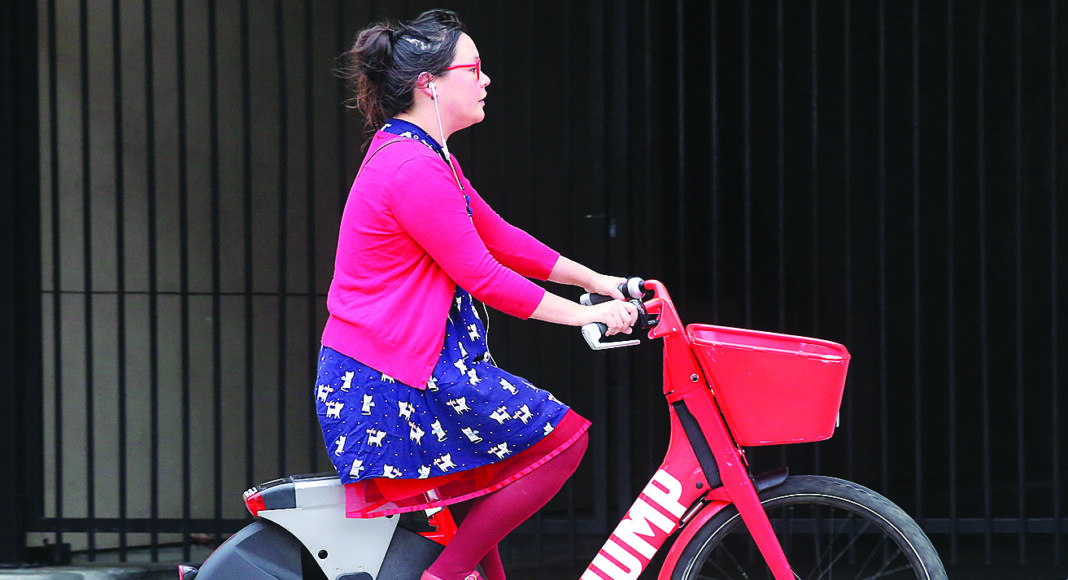Three years ago, red electric bikes zoomed across the city and were left in piles at Santa Cruz city limits.
In less than a week, the city will once again try out a new electric bike sharing. This time, local officials promise the issues that were prevalent with the ubiquitous red bikes have been solved.
On June 20, city officials will unveil the new electric bike sharing program, inviting the public to come and take a test ride and listen to guest speakers.
But what’s going to be different and why are the bikes coming back now?
A Different Approach
The color of the bikes—sleek black and white instead of the fire engine red—isn’t the only thing that will be different this time around.
While the red bikes were owned by JUMP, an Uber-run bike share system, the new ones are owned by BCycle, a company owned by Trek Bikes, of Wisconsin.
The bikes run $7 for half an hour, but there are monthly passes available for $30 and yearly passes for $150, in an effort to offer financially accessible options for regular riders and commuters.
Importantly, the BCycle model is dock based, which means that all bikes must be checked out and returned to a dock—or riders run the risk of racking up a $2,000 fine. This is different from the former JUMP system where bikes could be left anywhere—a big complaint from local residents, who were left to navigate around the discarded bikes.
But according to Claire Gallogly, transportation planner for the city, local residents have been anticipating the return of the bike sharing system.
“My favorite reaction is why has it taken so long for them to come back,” Gallogly says.
It’s a sentiment echoed by fourth year graduating UC Santa Cruz student Michael Wool.
“The bikes are spectacular because it really helps address that critical last mile of transit transportation,” Wool says. “That last mile is a make or break for public transportation. If the last mile is difficult, or the last mile involves getting in a car, that is a barrier to entry and that’s usually what makes people who have the means to choose to drive instead. I just wish it had happened sooner.”
Gallogly says that with the pandemic restrictions ending and summer right around the corner, now is the perfect time to launch the program the city has been planning for over a year.
“Bike share offers one more easy way for people to choose to make some trips on bike,” Santa Cruz Mayor Fred Keeley says. “This complements the overall goals of the city of reducing car trips within town and making biking, walking and public transit a convenient first choice.”
Keeley says he expects the primary bikers to be local, regular users, although there’s virtually no way to know whether bikers will be tourists, students or local commuters.
With JUMP, each bike saw almost five trips per day, and the average trip distance was 1.9 miles. On average, the bike share program saw over 25,000 trips per month.
“While we love for students and tourists to use bike share, the primary users will likely be locals,” Keely says.
The BCycle has a top speed of 17 mph and can provide power for about 25 miles per charge, according to the company.
Encouraging Equity
Looking at how many and where bikes are being allocated throughout each city in the county, it’s clear that the bikes are located in areas with high concentrations of students and tourists.
Santa Cruz will receive 300 bikes. UC Santa Cruz will receive around 100 bikes and Cabrillo College will get 50. Meanwhile, Capitola (with a population of around 9,000) will receive 50 bikes, while Watsonville (a population of 55,000) will receive 25.
Alex Yasbek, environmental projects manager for Watsonville, says that this isn’t coming as a surprise—all cities in the county were heavily involved in the process of divvying up the bikes and choosing the bike share company. In fact, he’s happy bikes are coming to Watsonville at all.
“Watsonville is a bit of an unknown for the bike share company, because we don’t have a college or a very large tourist industry,” Yasbek says. “There’s just not a whole lot of examples of cities like Watsonville that have bikeshare already. We’re really excited that the company is trying Watsonville and we’re hoping to show that it can be successful, because that then allows bikeshare to start happening in all these other cities that have, up to this point, been excluded from bikeshare programs.”
Watsonville—along with other jurisdictions besides the city of Santa Cruz—won’t be launching the bikeshare program until sometime in 2024.
When it does launch, Yasbek hopes to have a plan in place that allows for discounts or fee-waivers for low income riders or students. Right now, the bikes are limited to people 18 years old and up, but Yasbek wants Watsonville to spearhead a program for students using the bikes to get to and from home.
Riding Out
The bike launch on Tuesday will offer refreshments, have officials answering questions and going out on a ride when the bikes go live.
Keely, who plans on being at the launch, says that coupled with the investments the city is making to improve bike infrastructure, the new bike share system should help more people choose biking.
“In the past few years, we’ve expanded our network of enhanced bike lanes, added protected bike lanes on Water Street, completed Arana Gulch, built the first section of rail trail and made safety improvements at dozens of intersections to enhance biking and walking,” Gallogly says. She adds that this summer, the city will be constructing protected bike lanes on Bay between Escalona and Nobel, and adding protected bike lanes on Laurel. Early next year, the city will have the next section of rail trail complete.
If you go:
Where: Santa Cruz City Hall Courtyard
When: Tuesday June 20, 2PM













